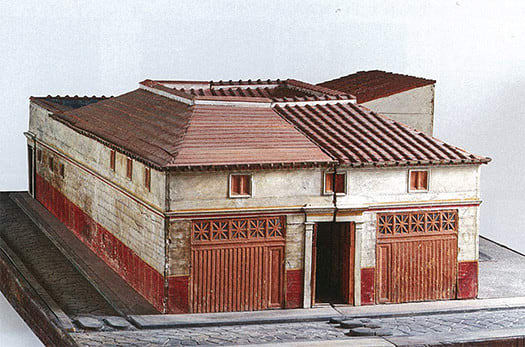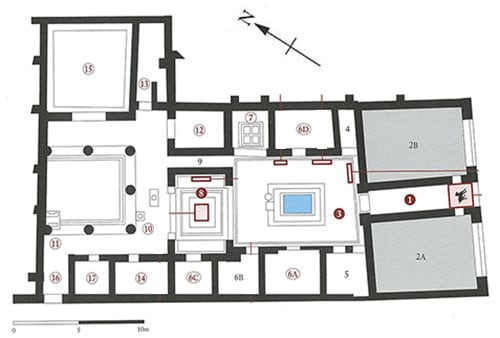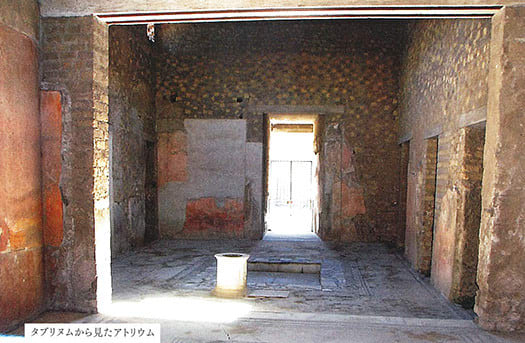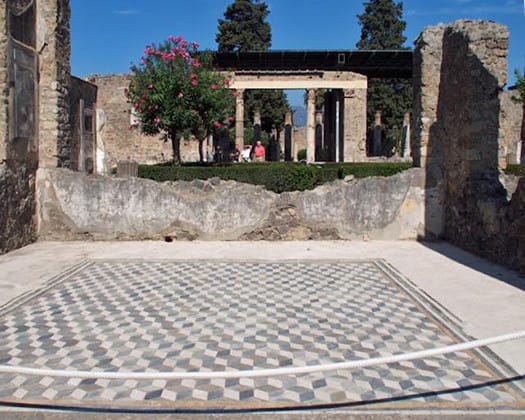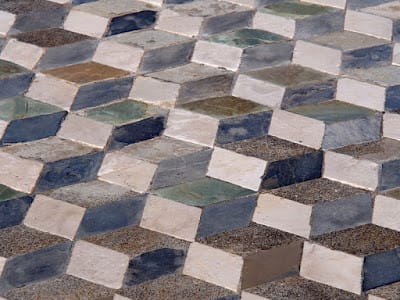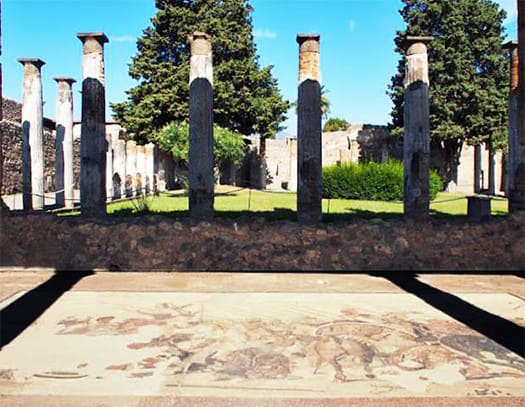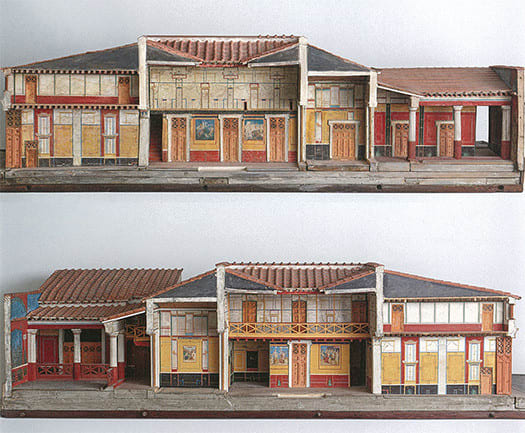
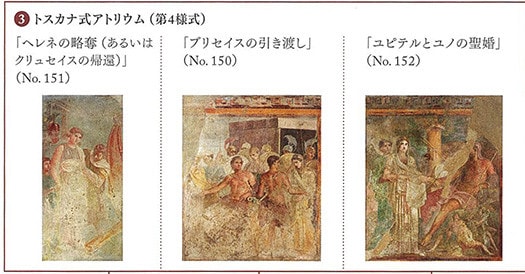
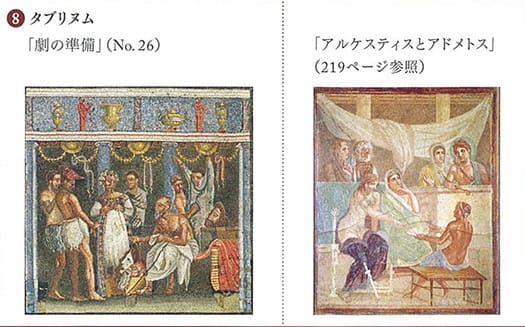
上の写真2点はこの「悲劇詩人の家」を飾っていたモザイク。
「猛犬注意」のユーモラスなモザイクは象徴性もあったのか床面だけれど、
これらの室内モザイクは壁面を飾っていたのだという。
このほかに3点のモザイク画が展示されていたとのこと。
この家は保存状態が良かったということにせよ、
これだけ多数の壁画、多くがかれらにとっての「神話」譚テーマ。
それも多くが「トロイア戦争」にまつわるものとされる。
トロイア戦争は、以下のような概要。
場所:小アジア(イリオス)
時代:青銅器時代
年月日:紀元前1700年-紀元前1200年頃のどこか。
・・・ということなので、この家の創建年代2200年前頃と比較して
さらに1500年前から800年前ころの叙事詩ということになる。
現代人に置き換えてみればイマドキの家で奈良・平安京のころの
王朝国家の叙事詩を壁面でピンナップしている状況になる。
自分の家でそういう特定テーマを深掘りするような人物が
この家の住み手には似つかわしいと考えられるけれど、
ふつうに考えれば、描かれた人物たちに血族意識濃厚だと考えている証拠か。
自らのアイデンティティを証す、という意味で残した。
ちょうどわれわれが祖先を祀るのに、仏壇を大切にしたり
肖像画や写真などを仏間に飾るような心理というのが推論1。
そうではなくこれは「歴史」数寄、一種のフェッチというのが推論2.
素材が石材ということでこうした古代人の精神世界のよすがが残る。
ひるがえって極東アジアの島国人はどうであったかと考えて見る。
人間の精神性には現代人とそう大きな違いはないとわたしは思う。
たぶんこの2000-3000年程度の時間・時代相違では
主役としての人間の精神性、思考パターンには違いがないのではないか。
ただその人の置かれた環境条件が違うことで対応が違う程度。
そのような見方からすれば、家系の個人資産としてモザイクを製作発注し
大切に残していくというような心理の分析からは
やはり推論1の可能性が高いのではないか。
日本人社会では古墳を造営したり神社を残したり、
仏教が社会に導入された以降には、家系の「仏壇」を残す心理と
いちばん同質性を感じられることがらのように思われる。
日本の場合は稲作という単一的な生産志向社会なので
このような「家系象徴」という心性は古墳に多く向かったのではないか。
ヨーロッパ地中海世界ポンペイではまた違う生産手段であって
そういう環境要因の違いということと思える。あるい極論としては
狩猟社会の人間性の基幹として「戦争」そのものが
そういう征服者的アイデンティティとして基底にあるのかも知れない。
アレクサンドル大王の征戦の様子をモザイクで残した大豪邸など、
そういう想像を強く刺激される。
われわれ日本人は木と土という建築表現が基本だと思うけれど
西洋や中国大陸などは基本はやはり石造。その文化の相違が色濃い。
English version⬇
What was the motive for the mosaic expression? Pompeii, House of the Tragic Poet-3]
An expression of the identity of their society. Or a means of expression of ancestor worship. In contrast, it is similar to the culture of Buddhist altars and ancient tombs.
The two photos above are mosaics that decorated the "House of the Tragic Poet".
The humorous mosaic "Beware of Raging Dogs" is on the floor, perhaps because of its symbolism.
The humorous mosaic of "Beware of Raging Dogs" is on the floor, but these mosaics decorated the walls.
Three other mosaics were also on display.
Even though the house was in a good state of preservation, the mosaics were not on display.
The house was in a good state of preservation, but there were so many murals, many of them with a "mythological" theme for them.
Many of them are related to the Trojan War.
The Trojan War is outlined as follows
Location: Asia Minor (Ilios)
Period: Bronze Age
Date: somewhere between 1700 B.C. - 1200 B.C.
...so compare this with the founding date of the house, around 2200 years ago.
This means that the epic poem was written around 1500 to 800 years ago, compared to the foundation of the house around 2200 years ago.
If we replace it with a modern person, it would be like a wall painting of an epic poem of the Nara/Heian-kyo period in a house of the Imadaki dynasty.
The epic poems of the dynasties in Nara and Heian-kyo period are pinned up on the wall in a modern house.
The inhabitants of this house are not the kind of people who would delve deeply into such a specific theme in their own home.
who would delve into such a specific theme in his own home.
However, it is also evidence of a strong sense of kinship among the people depicted in the painting.
The paintings were left as a proof of their own identity.
It is just like how we cherish a Buddhist altar to worship our ancestors, or how we keep portraits and photographs of our ancestors in our homes.
This is the same kind of mentality as when we cherish a Buddhist altar or display portraits and photographs in a Buddhist room to honor our ancestors.
The second inference is that this is a kind of fetch, a "historical" sukiyori.
The use of stone as a material is a trace of the spiritual world of the ancients.
In contrast, what about the islanders of Far East Asia?
I do not think that there is much difference in human spirituality from that of modern humans.
I think that the difference in time and period of the last 2000-3000 years is probably not so great.
I think there is no difference in the mentality and thought patterns of people as the main actors.
It is just that people respond differently due to the different environmental conditions in which they are placed.
From such a perspective, it would be a psychological analysis to order the production of a mosaic as a family's personal asset and to leave it behind with care.
The analysis of the mentality of ordering a mosaic as a family's personal asset and leaving it as a treasured possession suggests the following.
I think the possibility of inference 1 is still high.
In Japanese society, people have built ancient tombs and left behind shrines.
After Buddhism was introduced into society, the psychology of leaving behind family "butsudan" (Buddhist altars) and the most homogeneous psychology of leaving behind family "butsudan" may be felt.
In the case of Japan, the Japanese people are not interested in a single type of rice cultivation, but rather in the concept of "rice cultivation" as a means to preserve a single culture.
In the case of Japan, a mono-production-oriented society based on rice cultivation
This kind of "family symbolism" may have been more likely to be found in kofun tombs.
In the European Mediterranean world of Pompeii, the means of production is different.
I think the difference is due to such environmental factors. In the extreme
I think that "war" itself, as the backbone of human nature in a hunting society
as the basis of the conqueror identity of a hunting society.
The great mosaic of Alexander the Great's conquests, for example, strongly stimulates such an imagination.
This kind of imagination is strongly stimulated by the mosaic of Alexander the Great's conquests.
We Japanese think that the basic architectural expression is wood and earth.
while in the West and mainland China, the basic structure is stone. The difference between the two cultures is very strong.
















